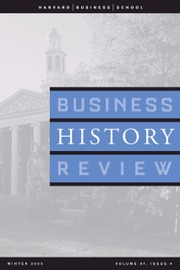The articles in this issue contribute to major themes of the journal, including the histories of innovation, business-government collaborations, and the relationship between businesses and the environment.
Andrew Primmer’s article, focusing on the British “gentlemanly capitalist” Shirley Jenks’s business group in Colombia, which invested in railways, steamships, and mining during the early twentieth century, demonstrates how financiers successfully utilized informal partnerships and capital markets to build and manage companies from afar. Matteo Calabrese and Valeria Giacomin analyze the ways in which business-government cooperation facilitated Luxembourg’s specialization in financial services, emphasizing how business elites leveraged personal relationships and influenced regulatory practices to shape the mutual fund industry beginning in the 1960s. Natalya Vinokurova and Rahul Kapoor examine The Eastman Kodak Company’s path to bankruptcy. Challenging conventional notions about strategic renewal and corporate decline, the company went bankrupt despite leading in the development of new technologies and its efforts to diversify its business.
Two articles focus on the intersection of business and the environment. George Colpitts and Andrew Goodwin’s article on the Hudson’s Bay Company explains how ecological change in the Arctic impacted the company’s place in the global value chain of the fox and polar bear trade in the first half of the twentieth century. Finally, Alice Milor examines standards-making in environmental regulations through the 1998 Automotive CO2 Agreement, arguing that the European Commission led the process and successfully limited the influence of the automobile lobby.

